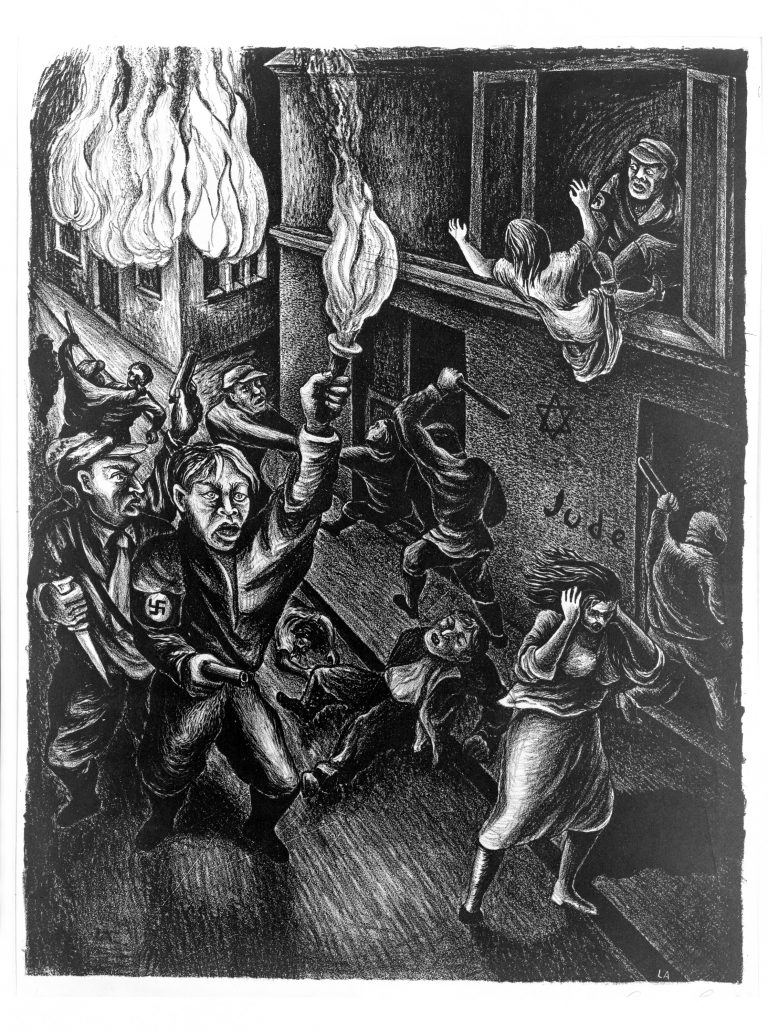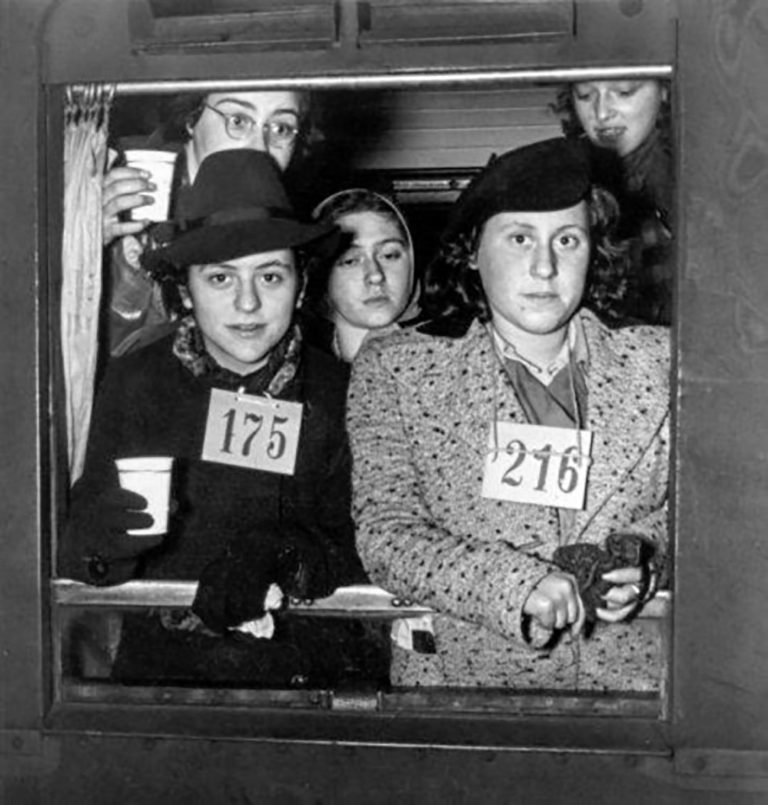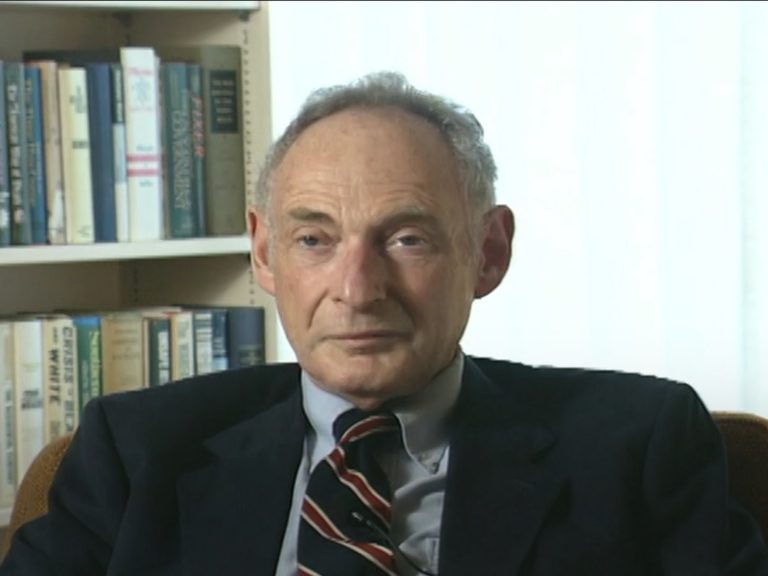Reactions to the November Terror
The images of brutal terror against Jews in Germany on November 9–10, 1938 shock the world. Many people become aware for the first time of just how precarious the situation of the Jewish population in the German Reich, including in the now-annexed Sudetenland, is. Especially in Western European countries, at the end of 1938 majorities of the public come out in favor of taking in more Jewish refugees.
The Netherlands, Belgium and France temporarily let in thousands of refugees, and Australia declares its willingness to take in 15,000 Jews over the next three years. The UK takes in some 10,000 Jewish children under the age of 17 from Germany, Austria, Poland and Czechoslovakia, while almost 4,000 more of these children are taken in by the Netherlands, Belgium, France and Sweden.
President Roosevelt recalls the US ambassador from Berlin in protest against the terror, and later calls for a trade embargo against the German Reich. However, he allows an initiative to take in 20,000 Jewish children to be blocked in Congress.

Luis Arenal, „Pogrom o persiguiendo a los judíos“, lithograph 1938
The Mexican painter, illustrator and sculptor Luis Arenal Bastar, a founding member of the League of Revolutionary Writers and Artists, expresses his horror at the state-organized terror against the Jews in Germany in his lithograph “Pogrom or persecution of the Jews.”
Luis Arenal Bastar / Library of Congress, Washington, DC, Prints & Photographs Division, LC-USZ62-44665
Luis Arenal, „Pogrom o persiguiendo a los judíos“, lithograph 1938
The Mexican painter, illustrator and sculptor Luis Arenal Bastar, a founding member of the League of Revolutionary Writers and Artists, expresses his horror at the state-organized terror against the Jews in Germany in his lithograph “Pogrom or persecution of the Jews.”
Luis Arenal Bastar / Library of Congress, Washington, DC, Prints & Photographs Division, LC-USZ62-44665

Annex to the report of the German legation in Bern to the Foreign Office, November 19, 1938
In reaction to the pogrom-like acts of violence, the Netherlands’ government does not only temporarily open the country’s borders to thousands of refugees, but also appeals to other countries to make their policies toward refugees more generous – in the case of the Swiss Federal Council, though, these efforts are largely in vain.
Auswärtiges Amt / Politisches Archiv, Berlin, Bern 1962
Annex to the report of the German legation in Bern to the Foreign Office, November 19, 1938
In reaction to the pogrom-like acts of violence, the Netherlands’ government does not only temporarily open the country’s borders to thousands of refugees, but also appeals to other countries to make their policies toward refugees more generous – in the case of the Swiss Federal Council, though, these efforts are largely in vain.
Auswärtiges Amt / Politisches Archiv, Berlin, Bern 1962

Arrival of a „Kindertransport“ at Waterloo Station, London, Februar 2, 1939
In mid-November 1938, the British government authorizes the entry of Jewish children and teenagers into the United Kingdom after Jewish organizations commit to pay for the children’s travel costs and find foster homes for them. Between December 1938 and September 1939, 10,000 young people arrive in the UK. Because of a shortage of foster families, many of these children are exploited as servants or placed in institutions. Their separation from their parents and the murder of their family members in the Holocaust leaves many of the rescued children severely traumatized.
Österreichische Nationalbibliothek, Wien, S 52/11
Arrival of a „Kindertransport“ at Waterloo Station, London, Februar 2, 1939
In mid-November 1938, the British government authorizes the entry of Jewish children and teenagers into the United Kingdom after Jewish organizations commit to pay for the children’s travel costs and find foster homes for them. Between December 1938 and September 1939, 10,000 young people arrive in the UK. Because of a shortage of foster families, many of these children are exploited as servants or placed in institutions. Their separation from their parents and the murder of their family members in the Holocaust leaves many of the rescued children severely traumatized.
Österreichische Nationalbibliothek, Wien, S 52/11

Arrival of a “Kindertransport” at the Nijmegen train station, 1938
Most of the children travel first by train to the Netherlands, then by ship onward to Harwich, where they are taken to London on trains. At the train stations in the Netherlands, the young refugees, who are only allowed to bring one suitcase, one bag, and ten reichsmarks with them, are often greeted with drinks and sweets. Some 1,500 children find refuge in the Netherlands.
Collectie Spaarnestad / Het Leven, Nationaal Archief, Den Haag
Arrival of a “Kindertransport” at the Nijmegen train station, 1938
Most of the children travel first by train to the Netherlands, then by ship onward to Harwich, where they are taken to London on trains. At the train stations in the Netherlands, the young refugees, who are only allowed to bring one suitcase, one bag, and ten reichsmarks with them, are often greeted with drinks and sweets. Some 1,500 children find refuge in the Netherlands.
Collectie Spaarnestad / Het Leven, Nationaal Archief, Den Haag

Arrival of Jewish children from Poland on the steamer “Warszawa” in London, February 1939
Children of Polish Jews who have been deported during the “Polen-Aktion” into the German-Polish border region find refuge in Great Britain, too.
Bundesarchiv, Koblenz, Bild 183-S69279
Arrival of Jewish children from Poland on the steamer “Warszawa” in London, February 1939
Children of Polish Jews who have been deported during the “Polen-Aktion” into the German-Polish border region find refuge in Great Britain, too.
Bundesarchiv, Koblenz, Bild 183-S69279

Stanley Melbourne Bruce, 1934
The Australian High Commissioner in London and former prime minister of Australia reports to his government at the end of November 1938 about an international wave of outrage about the persecution of Jews in Germany. Following the positions of many other countries, he writes that Australia should express its willingness to take in 30,000 refugees within the next three years.
Fairfax Syndication, Sydney
Stanley Melbourne Bruce, 1934
The Australian High Commissioner in London and former prime minister of Australia reports to his government at the end of November 1938 about an international wave of outrage about the persecution of Jews in Germany. Following the positions of many other countries, he writes that Australia should express its willingness to take in 30,000 refugees within the next three years.
Fairfax Syndication, Sydney

“15,000 German Jews for Australia,” London Evening News, December 1, 1938
On December 1, 1938, the Australian Interior Minister tells the parliament that the government intends to take in 15,000 Jewish refugees from Germany in the following three years. People who have skills related to the development of industries are to be given priority. Admitting a larger number of people, he says, would have a negative impact on Australia’s labor market and standard of living.
Franklin D. Roosevelt Library, Hyde Park, NY
“15,000 German Jews for Australia,” London Evening News, December 1, 1938
On December 1, 1938, the Australian Interior Minister tells the parliament that the government intends to take in 15,000 Jewish refugees from Germany in the following three years. People who have skills related to the development of industries are to be given priority. Admitting a larger number of people, he says, would have a negative impact on Australia’s labor market and standard of living.
Franklin D. Roosevelt Library, Hyde Park, NY

Actress Helen Hayes flanked by Senator Robert F. Wagner (New York) and Representative Edith Nourse Rogers (Massachusetts) before the US Senate subcommittee on immigration, April 20, 1939
Democrat Wagner and Republican Rogers introduce a bill to allow 20,000 refugee children to enter the United States above the annual quota for German immigrants. They are supported by celebrities such as actress Helen Hayes, who speaks on behalf of the bill before the Senate subcommittee on immigration “as an American mother.” The initiative fails, however, due to strong opposition to it and a lack of support from the Roosevelt administration.
Harris & Ewing / Library of Congress, Washington, DC, Prints & Photographs Division, LC-H22-D- 6377
Actress Helen Hayes flanked by Senator Robert F. Wagner (New York) and Representative Edith Nourse Rogers (Massachusetts) before the US Senate subcommittee on immigration, April 20, 1939
Democrat Wagner and Republican Rogers introduce a bill to allow 20,000 refugee children to enter the United States above the annual quota for German immigrants. They are supported by celebrities such as actress Helen Hayes, who speaks on behalf of the bill before the Senate subcommittee on immigration “as an American mother.” The initiative fails, however, due to strong opposition to it and a lack of support from the Roosevelt administration.
Harris & Ewing / Library of Congress, Washington, DC, Prints & Photographs Division, LC-H22-D- 6377

Reactions to the November Terror 1938: „Kindertransporte“ I
Clips from Interview with Sylvia Schneider formerly Balbierer, September 25, 1997 Jackson Heights, New York, USA
© USC Shoah Foundation Visual History Archive, Los Angeles, Interview Code: 33965
Reactions to the November Terror 1938: „Kindertransporte“ I
Clips from Interview with Sylvia Schneider formerly Balbierer, September 25, 1997 Jackson Heights, New York, USA
© USC Shoah Foundation Visual History Archive, Los Angeles, Interview Code: 33965

Reactions to the November Terror 1938: „Kindertransporte“ II
Clips from interview with Susanne Perl, November 1, 1996, Teaneck, New Jersey, USA
© USC Shoah Foundation Visual History Archive, Los Angeles, Interview Code: 21986
Reactions to the November Terror 1938: „Kindertransporte“ II
Clips from interview with Susanne Perl, November 1, 1996, Teaneck, New Jersey, USA
© USC Shoah Foundation Visual History Archive, Los Angeles, Interview Code: 21986

Reactions to the November Terror 1938: „Kindertransporte“ III
Clips from Interview with Frank Gittler, August 2, 1996, Allentown, Pennsylvania, USA
© USC Shoah FoundationVisual History Archive, Los Angeles, Interview Code: 18143
Reactions to the November Terror 1938: „Kindertransporte“ III
Clips from Interview with Frank Gittler, August 2, 1996, Allentown, Pennsylvania, USA
© USC Shoah FoundationVisual History Archive, Los Angeles, Interview Code: 18143

Reactions to the November Terror 1938: „Kindertransporte“ IV
Clips from Interview with William Ehrlich, December 12, 1996, San Francisco, California, USA
© USC Shoah Foundation Visual History Archive, Los Angeles, Interview Code: 24151
Reactions to the November Terror 1938: „Kindertransporte“ IV
Clips from Interview with William Ehrlich, December 12, 1996, San Francisco, California, USA
© USC Shoah Foundation Visual History Archive, Los Angeles, Interview Code: 24151






